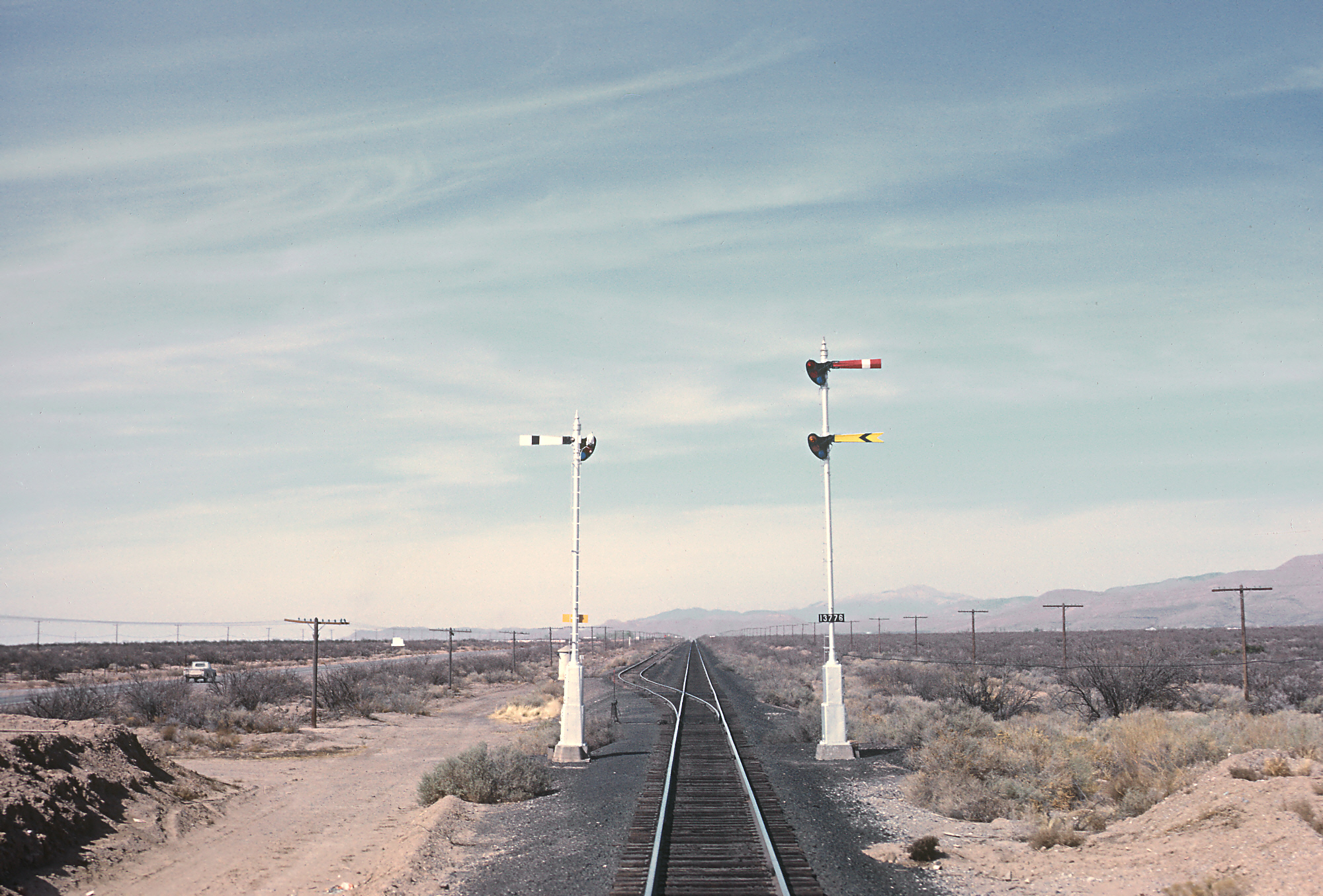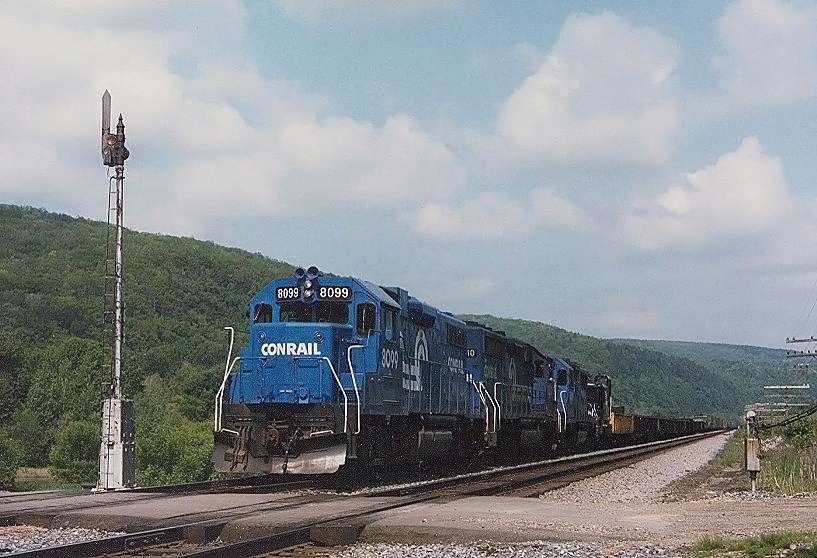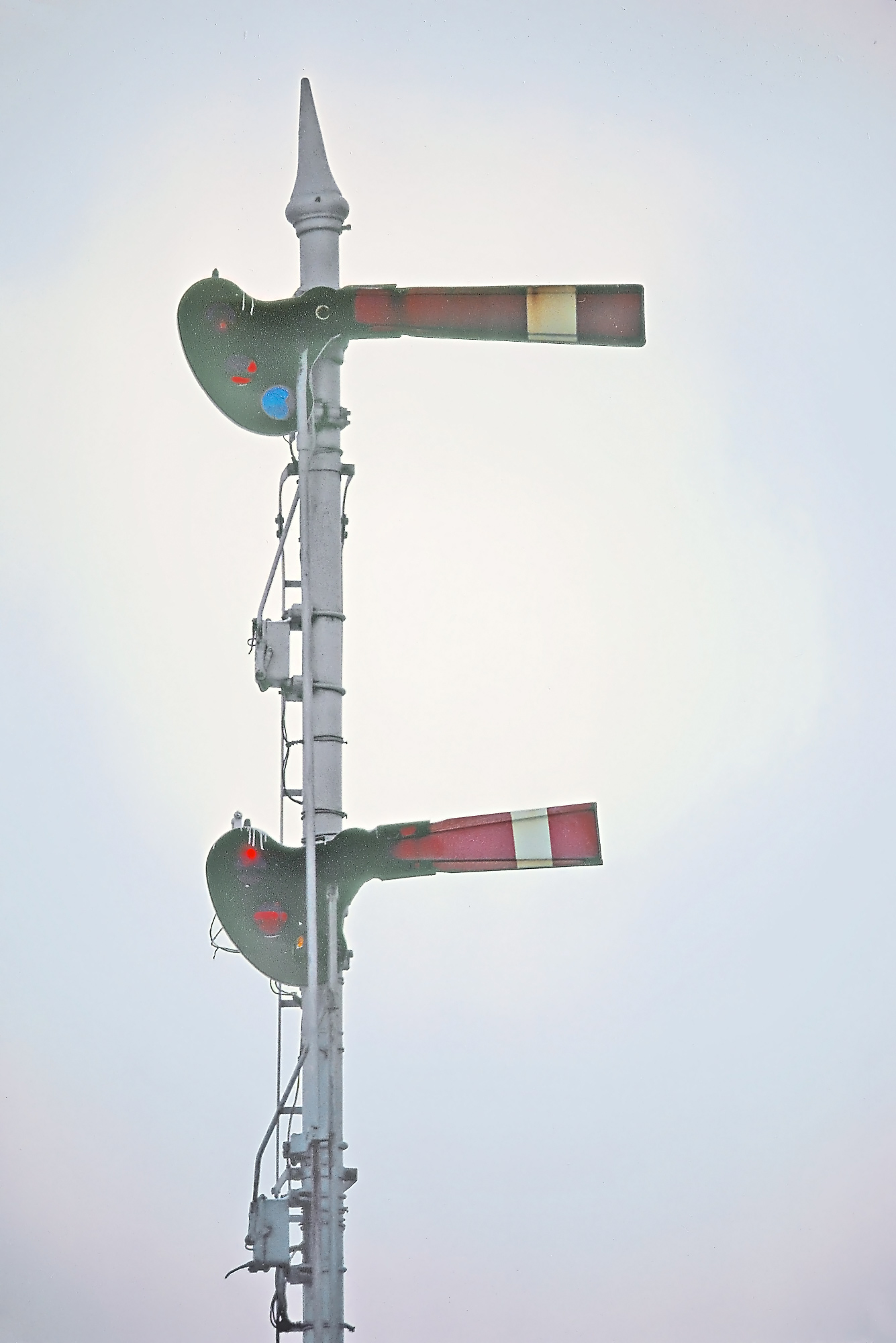- Home ›
- Glossary ›
- Semaphores
The Semaphore: Railroading's Classic Signal
Published: July 4, 2024
By: Adam Burns
In the annals of railroad history, the semaphore signal stands as an emblem of ingenuity and progress.
It was a pivotal element in the orchestration of train movements, leveraging simple mechanical principles to ensure communication and safety across burgeoning rail networks.
This article provides a detailed examination of the semaphore signal, its historical context, functional mechanics, and eventual decline in favor of more modern signaling methods.
 Roger Puta photographed these Southern Pacific lower quadrent semaphores near Orogrande, New Mexico from the rear of Train #3, the "Golden State." on March 20, 1967.
Roger Puta photographed these Southern Pacific lower quadrent semaphores near Orogrande, New Mexico from the rear of Train #3, the "Golden State." on March 20, 1967.Historical Background
The rise of railroads in the 19th century heralded an era where efficient and reliable communication was paramount for safety. Before semaphore signals, early railways relied on human signalmen and rudimentary visual signals, such as flags and lamps, to convey information. However, these methods were prone to errors and were severely limited by visibility conditions.
The semaphore signal was developed to address these shortcomings. Historians attribute the invention of the semaphore signal to the British engineer Charles Hutton Gregory, who introduced it to the South Eastern Railway in the 1840s.
The design quickly proved superior to its predecessors, offering clear, unambiguous signals that could be seen from a considerable distance under various light conditions.
Design and Functionality
A semaphore signal typically consists of a vertical post with an arm that pivots at its midpoint. The arm can be positioned at different angles to convey distinct instructions to train engineers.
The semaphore signal's arm movements are mechanically controlled, either manually by a signal operator or by remote mechanical linkages.
Components
1. **Post and Arm:**
- The main structure comprises a vertical post, usually made of wood or steel, and a pivoting arm. The arm positions determine the signal it conveys.
2. **Spectacle and Lenses:**
- Attached to the arm is the "spectacle" frame that holds colored lenses. When illuminated at night, these lenses provide visual signals: typically red for stop, green for go, and yellow for proceed with caution.
3. **Counterbalances and Control Mechanisms:**
- Counterweights balance the arm and ensure smooth operation. Control rods or wires connect the arm to a lever in a signal cabin, enabling the signalman to change the arm's position.
Signal Positions
The standard semaphore signal positions and their meanings are as follows:
1. **Horizontal Arm (90 degrees):**
- **Stop:** The train must halt and await further instructions. This is typically associated with the red light at night.
2. **Lowered Arm (45 degrees, downward to the right):**
- **Proceed:** The train is cleared to move forward. This position is crucial for maintaining traffic flow on busy rail lines and normally corresponds to a green light in darkness.
3. **Midway Position (either 45 degrees downward to the left or vertical upward):**
- **Caution:** This position instructs the train to proceed with caution, being prepared to stop if necessary. This setting is often tied to a yellow light at night.
Operational Mechanics
Manual Operation
In the early days of semaphore signals, operation was entirely manual. Signalmen, stationed in signal boxes along the railway, controlled the signals. These operators moved the semaphore arms using levers connected by an intricate system of rods and wires.
Manual operation required precise timing and careful coordination, especially at busy junctions. Signalmen had to be well-trained and vigilant to prevent misunderstandings and ensure safety.
Automated Mechanisms
As technology advanced, railway companies explored ways to automate semaphore signals to reduce human error and increase efficiency.
Electro-mechanical devices were introduced, allowing signals to be controlled from a central location.
Early forms of automation used electrically powered motors to adjust the semaphore arms, further enhancing the reliability and speed of signaling processes.
Decline and Replacement
Despite their efficacy, semaphore signals began to fall out of favor in the mid-20th century. This decline was driven by several factors:
1. **Advances in Technology:**
- The advent of electronic signaling systems offered more sophisticated and reliable means of communication. These systems, including color light signals and cab signaling, provided clearer, more precise instructions and could be integrated with automated train control systems.
2. **Maintenance and Operational Costs:**
- Semaphore signals, while robust, required regular maintenance due to their mechanical nature. Moving parts were subject to wear and tear. In contrast, electronic systems had lower operational costs and required less physical infrastructure.
3. **Visibility and Human Factors:**
- While semaphore signals were innovative for their time, they had limitations. Visibility could be impaired by weather conditions, and interpreting the signal required a clear line of sight.
- Light signals were more visible over greater distances and under various weather conditions.
4. **Standardization:**
- As rail networks expanded globally, there was a push towards standardization. Electronic signaling systems offered a level of standardization that semaphore signals could not match, facilitating international rail operations and interoperability.
Legacy and Preservation
Though largely replaced, semaphore signals have left an indelible mark on railway history. They represent a period of significant technological advancement and adaptation to the needs of rapidly growing rail networks.
Preservation Efforts
Several railway museums and heritage railways have preserved semaphore signals as part of their exhibits. Organizations dedicated to railway history and preservation recognize the semaphore signal's historical importance and work to maintain these artifacts for future generations.
Educational Value
Semaphore signals continue to be valuable educational tools. They provide insight into the evolution of railway technology and the challenges faced by early railway engineers.
By studying semaphore signals, students and enthusiasts can appreciate the ingenuity and innovation that characterized the early days of rail travel.
 Conrail GP38-2 #8099 leads freight ELOI past a classic ex-Erie/Erie Lackawanna semaphore on the Southern Tier near Addison, New Yor, on May 24, 1986. Doug Kroll photo.
Conrail GP38-2 #8099 leads freight ELOI past a classic ex-Erie/Erie Lackawanna semaphore on the Southern Tier near Addison, New Yor, on May 24, 1986. Doug Kroll photo.Conclusion
The semaphore signal was a cornerstone of railroad safety and efficiency during a transformative period in transportation history.
Its design and functionality addressed the critical need for reliable communication on rapidly expanding rail networks. While modern technology has rendered semaphore signals largely obsolete, their legacy endures in the annals of railway history.
Through preservation and education, the story of semaphore signals continues to inspire and inform, reminding us of the ever-evolving journey of technological progress in the rail industry.
Recent Articles
-
Wisconsin Dinner Train Rides In North Freedom!
Jan 06, 26 10:18 PM
Featured here is a practical guide to Mid-Continent’s dining train concept—what the experience is like, the kinds of menus the museum has offered, and what to expect when you book. -
Pennsylvania Dinner Train Rides In Boyertown!
Jan 06, 26 06:48 PM
With beautifully restored vintage equipment, carefully curated menus, and theatrical storytelling woven into each trip, the Colebrookdale Railroad offers far more than a simple meal on rails. -
North Carolina ~ Murder Mystery ~ Dinner Train Ride
Jan 06, 26 11:26 AM
While there are currently no murder mystery dinner trains in the Tarheel State the Burgaw Depot does host a murder mystery dinner experience in September! -
Florida's - Murder Mystery - Dinner Train Rides
Jan 06, 26 11:23 AM
Florida, known for its vibrant culture, dazzling beaches, and thrilling theme parks, also offers a unique blend of mystery and fine dining aboard its murder mystery dinner trains. -
New Mexico's - Wine Tasting - Train Rides
Jan 06, 26 11:19 AM
For oenophiles and adventure seekers alike, wine tasting train rides in New Mexico provide a unique opportunity to explore the region's vineyards in comfort and style. -
Ohio's - Wine Tasting - Train Rides
Jan 06, 26 11:14 AM
Among the intriguing ways to experience Ohio's splendor is aboard the wine tasting trains that journey through some of Ohio's most picturesque vineyards and wineries. -
Connecticut's Thomas The Train Rides
Jan 06, 26 11:06 AM
For 2026, the tour stop at Essex brings Thomas (and Percy, too) to the historic Valley Railroad for a full day of events for the kids. -
Maryland's Thomas The Train Rides
Jan 06, 26 11:00 AM
In 2026, the B&O Railroad Museum in Baltimore welcomes the Let’s Rock, Let’s Roll Tour with four event days that combine a Thomas-themed excursion with other activities. -
Tennessee's Thomas The Train Rides
Jan 06, 26 10:51 AM
Set on the grounds of one of the Southeast’s best-known operating railroad museums, the Thomas the train event blends kid-friendly fun with the unmistakable sights, sounds, and atmosphere of a real wo… -
Georgia's Thomas The Train Rides
Jan 06, 26 10:44 AM
Day Out With Thomas is set to roll back into Cordele in 2026, bringing Thomas the Tank Engine and a full family festival to the SAM Shortline at Georgia Veterans Memorial State Park. -
Staten Island Rapid Transit
Jan 06, 26 10:02 AM
The Staten Island Rapid Transit has long served Staten Island since the 19th century and today is known as the Staten Island Railway. -
New York Dinner Train Rides In The Adirondacks!
Jan 05, 26 09:45 PM
Operating over a restored segment of the former New York Central’s Adirondack Division, the Adirondack Railroad has steadily rebuilt both track and public interest in passenger rail across the region. -
Ohio Dinner Train Rides On The CVSR!
Jan 05, 26 08:32 PM
While the railroad is well known for daytime sightseeing and seasonal events, one of its most memorable offerings is its evening dining program—an experience that blends vintage passenger-car ambience… -
Pennsylvania's - Wine Tasting - Train Rides
Jan 05, 26 01:08 PM
Wine tasting trains are a unique and enchanting way to explore the state’s burgeoning wine scene while enjoying a leisurely ride through picturesque landscapes. -
West Virginia - Wine Tasting - Train Rides
Jan 05, 26 01:02 PM
West Virginia, often celebrated for its breathtaking landscapes and rich history, offers visitors a unique way to explore its rolling hills and picturesque vineyards: wine tasting trains. -
Virginia - Wine Tasting - Train Rides
Jan 05, 26 12:58 PM
Wine tasting trains in Virginia provide just that—a unique experience that marries the romance of rail travel with the sensory delights of wine exploration. -
Utah - Wine Tasting - Train Rides
Jan 05, 26 12:37 PM
Utah, a state widely celebrated for its breathtaking natural beauty and dramatic landscapes, is also gaining recognition for an unexpected yet delightful experience: wine tasting trains. -
Kentucky Valentine's Train Rides
Jan 05, 26 12:31 PM
If you’re looking for a date night that feels a little more cinematic than the usual reservation-and-a-movie routine, Bardstown’s My Old Kentucky Dinner Train delivers the kind of evening you remember… -
Pennsylvania Valentine's Train Rides
Jan 05, 26 12:12 PM
Tucked amid the rolling farmland of Lancaster County, Pennsylvania, the Strasburg Rail Road stands as one of the most celebrated and successful heritage railroads in North America. -
New York's - Murder Mystery - Dinner Train Rides
Jan 05, 26 11:01 AM
New York State, renowned for its vibrant cities and verdant countryside, offers a plethora of activities for locals and tourists alike, including murder mystery train rides!





















